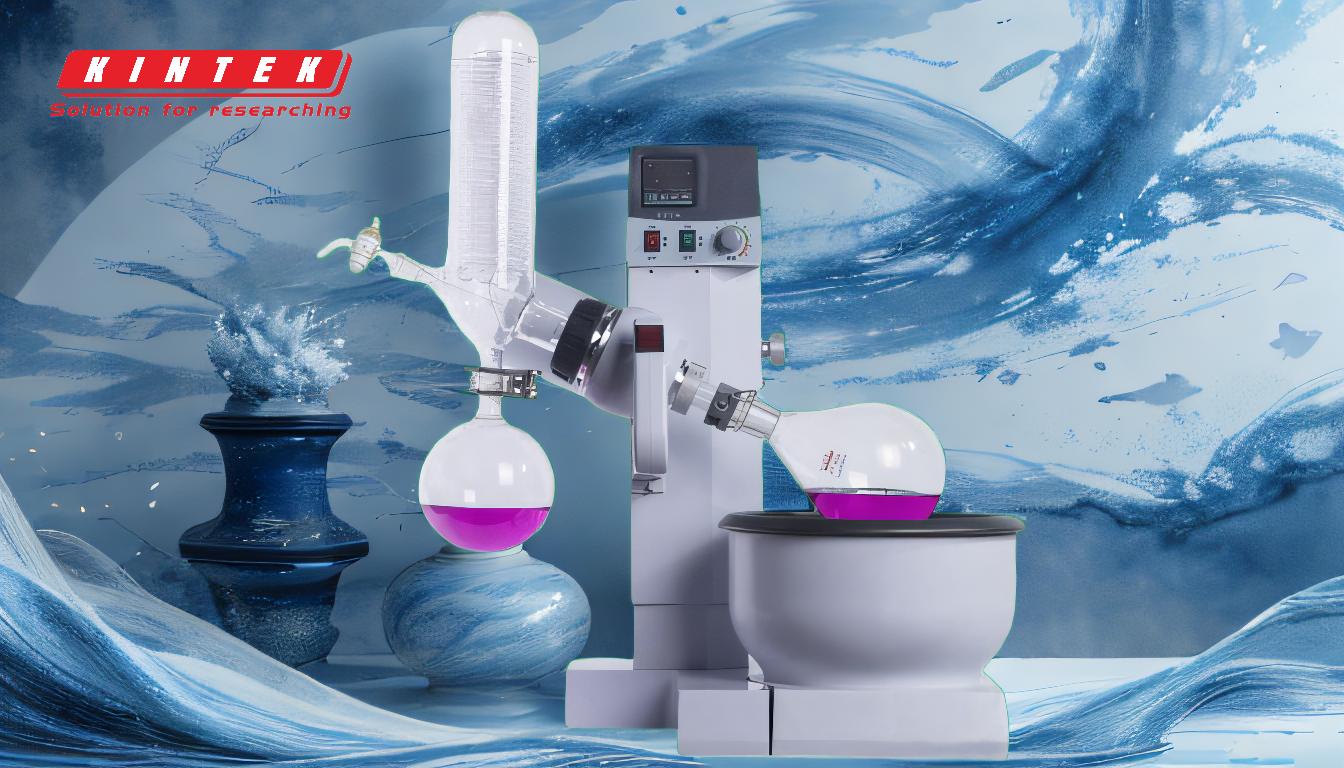Rotary evaporators and freeze dryers are both essential pieces of equipment in laboratories for solvent removal and sample drying, but they operate on fundamentally different principles and are suited for different applications. A rotary evaporator uses a heated fluid bath to evaporate solvents under reduced pressure, making it ideal for bulk solvent removal and concentrating samples. In contrast, a freeze dryer (lyophilizer) removes solvents by freezing the sample and then sublimating the ice under vacuum, preserving the structure and integrity of heat-sensitive materials. While rotary evaporators are versatile and widely used for solvent removal, freeze dryers are preferred for delicate samples requiring low-temperature processing and long-term stability.
Key Points Explained:

1. Working Principle
-
Rotary Evaporator:
- Uses a heated fluid bath (water or oil) to heat the sample flask.
- Operates under reduced pressure to lower the boiling point of solvents.
- The rotating flask creates a thin film of solvent, enhancing evaporation efficiency.
-
Freeze Dryer:
- Freezes the sample to a solid state.
- Applies a vacuum to sublimate the frozen solvent (ice) directly into vapor.
- Preserves the sample's structure and biological activity by avoiding liquid phase transitions.
2. Temperature Control
-
Rotary Evaporator:
- Relies on elevated temperatures (typically 30–60°C) to evaporate solvents.
- Suitable for heat-stable compounds but may degrade heat-sensitive materials.
-
Freeze Dryer:
- Operates at low temperatures (below freezing, often -50°C or lower).
- Ideal for heat-sensitive samples like proteins, enzymes, and pharmaceuticals.
3. Application Scope
-
Rotary Evaporator:
- Best for bulk solvent removal and concentrating solutions.
- Commonly used in chemistry, pharmaceuticals, and food industries.
-
Freeze Dryer:
- Used for drying delicate samples that require structural preservation.
- Widely applied in biotechnology, pharmaceuticals, and food preservation.
4. Sample Integrity
-
Rotary Evaporator:
- May cause thermal degradation of heat-sensitive compounds.
- Not suitable for preserving biological activity or delicate structures.
-
Freeze Dryer:
- Maintains sample integrity by avoiding high temperatures.
- Preserves biological activity, texture, and flavor in sensitive materials.
5. Speed and Efficiency
-
Rotary Evaporator:
- Faster for bulk solvent removal due to direct heating and reduced pressure.
- Less efficient for complete drying of samples with low volatility.
-
Freeze Dryer:
- Slower process due to the need for freezing and sublimation.
- More efficient for complete drying and long-term stability of sensitive materials.
6. Equipment Complexity and Cost
-
Rotary Evaporator:
- Relatively simple design with lower upfront and operational costs.
- Requires regular maintenance of the vacuum pump and fluid bath.
-
Freeze Dryer:
- More complex system with higher upfront and operational costs.
- Requires specialized training for operation and maintenance.
7. Output Characteristics
-
Rotary Evaporator:
- Produces concentrated residues in the original flask.
- Suitable for recovering solvents and concentrating compounds.
-
Freeze Dryer:
- Produces a dry, porous product that can be easily rehydrated.
- Ideal for creating stable powders or preserving biological samples.
8. Industry Use Cases
-
Rotary Evaporator:
- Used in chemical synthesis, solvent recovery, and food flavor extraction.
- Commonly employed in academic and industrial labs for routine solvent removal.
-
Freeze Dryer:
- Used in pharmaceutical manufacturing for stabilizing vaccines and drugs.
- Applied in food processing for producing freeze-dried fruits, coffee, and instant meals.
9. Energy Consumption
-
Rotary Evaporator:
- Consumes less energy compared to freeze dryers.
- Energy usage primarily for heating the fluid bath and maintaining vacuum.
-
Freeze Dryer:
- Higher energy consumption due to freezing and prolonged sublimation processes.
- Requires significant power for maintaining low temperatures and vacuum.
10. Scalability
-
Rotary Evaporator:
- Easily scalable for larger volumes with larger flasks and baths.
- Suitable for both small-scale lab use and industrial applications.
-
Freeze Dryer:
- Scalable but often limited by the size of the freezing chamber.
- Industrial freeze dryers are available but require significant investment.
In summary, the choice between a rotary evaporator and a freeze dryer depends on the specific requirements of the sample and the desired outcome. Rotary evaporators are ideal for routine solvent removal and concentration, while freeze dryers are essential for preserving the integrity of heat-sensitive and delicate materials.
Summary Table:
| Feature | Rotary Evaporator | Freeze Dryer |
|---|---|---|
| Working Principle | Heated fluid bath evaporates solvents under reduced pressure. | Freezes samples and sublimates ice under vacuum. |
| Temperature Control | Elevated temperatures (30–60°C). | Low temperatures (below -50°C). |
| Application Scope | Bulk solvent removal, concentration. | Drying delicate, heat-sensitive samples. |
| Sample Integrity | May degrade heat-sensitive materials. | Preserves structure and biological activity. |
| Speed and Efficiency | Faster for bulk solvent removal. | Slower but more efficient for complete drying. |
| Equipment Complexity | Simpler design, lower cost. | More complex, higher cost. |
| Output Characteristics | Concentrated residues in the flask. | Dry, porous product for easy rehydration. |
| Industry Use Cases | Chemical synthesis, solvent recovery, food flavor extraction. | Pharmaceuticals, biotechnology, food preservation. |
| Energy Consumption | Lower energy usage. | Higher energy usage. |
| Scalability | Easily scalable for larger volumes. | Limited by freezing chamber size, higher investment for industrial use. |
Still unsure which equipment is right for your lab? Contact our experts today for personalized advice!












